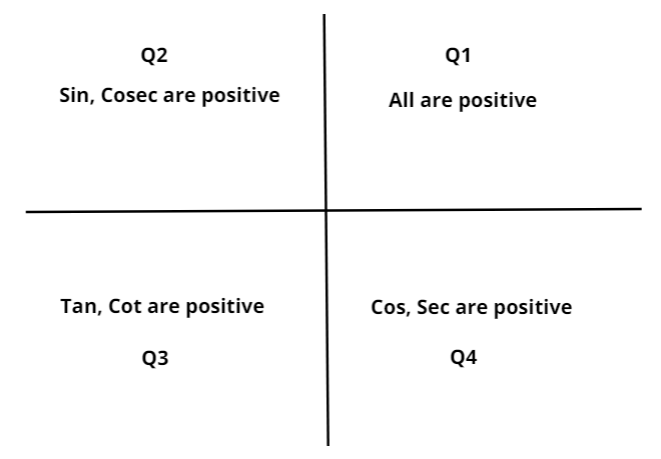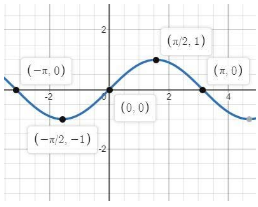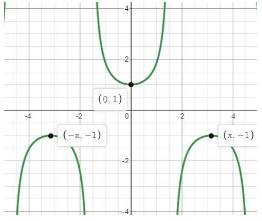
If \[\operatorname{Sin} \theta > 0,\operatorname{Sec} \theta < 0\], then $\theta $ lies in which quadrant
A: First
B: Second
C: Third
D: Fourth
Answer
569.1k+ views
Hint: We know in second quadrant only $\operatorname{Sin} \theta \& \operatorname{Cos} ec\theta $ are positive and rest all $\operatorname{Cos} \theta ,\operatorname{Sec} \theta ,\operatorname{Tan} \theta ,Cot\theta $ are negative So for second quadrant we can write
\[\operatorname{Sin} \theta > 0,\operatorname{Cos} ec\theta > 0,\operatorname{Sec} \theta < 0,\operatorname{Cos} \theta < 0,\operatorname{Tan} \theta < 0,Cot\theta < 0\] hence we can find the answer
Complete step-by-step answer:
As we know that the angles are classified into four quadrants, that is, $1^{st},2^{nd},3^{rd},4^{th}$. So basically a round circle is of a circle is of ${360^ \circ }$ angle so to make a circle we need an angle of ${360^ \circ }$ so this ${360^ \circ }$ is divided into $4$ parts
${\rm I}$ The first part is called $1stQuadrant$ in which the angle lies between ${0^\circ}to{90^\circ}$. If the angle is between ${0^\circ} to {90^\circ}$ then that angle lies in first quadrant and in first quadrant we know \[\operatorname{Sin} \theta ,\operatorname{Cos} ec\theta ,\operatorname{Sec} \theta ,\operatorname{Cos} \theta ,\operatorname{Tan} \theta ,Cot\theta \] all are positive so we can write in the first quadrant \[\operatorname{Sin} \theta > 0,\operatorname{Cos} ec\theta > 0,\operatorname{Sec} \theta > 0,\operatorname{Cos} \theta > 0,\operatorname{Tan} \theta > 0,Cot\theta > 0\]
${\rm I}{\rm I}$ Now if angle lies between ${90^\circ} to {180^\circ}$ then that range is termed as second quadrant for example: If $\theta = {120^\circ}$ then it lies in second quadrant now we know that in second quadrant $\operatorname{Sin} \theta \& \operatorname{Cos} ec\theta $ are positive and rest all $\operatorname{Cos} \theta ,\operatorname{Sec} \theta ,\operatorname{Tan} \theta ,Cot\theta $ are negative so we can say that in second quadrant \[\operatorname{Sin} \theta > 0,\operatorname{Cos} ec\theta > 0,\operatorname{Sec} \theta < 0,\operatorname{Cos} \theta < 0,\operatorname{Tan} \theta < 0,Cot\theta < 0\].
${\rm I}{\rm I}{\rm I}$ If angle lies between ${180^\circ} to {270^\circ}$ then that range is termed as third quadrant. for example: If $\theta = {200^\circ}$ then it lies in third quadrant now we know that in third quadrant $\operatorname{Tan} \theta \& Cot\theta $ are positive and rest all $\operatorname{Cos} \theta ,\operatorname{Sec} \theta ,\operatorname{Sin} \theta ,\operatorname{Cos} ec\theta $ are negative so we can say that in third quadrant \[\operatorname{Sin} \theta < 0,\operatorname{Cos} ec\theta < 0,\operatorname{Sec} \theta < 0,\operatorname{Cos} \theta < 0,\operatorname{Tan} \theta > 0,Cot\theta > 0\].
${\rm I}V$ If angle lies between ${270^\circ} to {360^\circ}$ then that range is termed as fourth quadrant. for example: If $\theta = {300^\circ}$ then it lies in fourth quadrant now we know that in fourth quadrant $\operatorname{Sec} \theta \& Cos\theta $ are positive and rest all $Cot\theta ,\operatorname{Tan} \theta ,\operatorname{Sin} \theta ,\operatorname{Cos} ec\theta $ are negative so we can say that in fourth quadrant \[\operatorname{Sin} \theta < 0,\operatorname{Cos} ec\theta < 0,\operatorname{Sec} \theta > 0,\operatorname{Cos} \theta > 0,\operatorname{Tan} \theta < 0,Cot\theta < 0\].

So here we are given that if $\operatorname{Sin} \theta > 0,\operatorname{Sec} \theta < 0$ so we can conclude that
$({\rm I})$ In $1^{st}$ Quadrant: $\operatorname{Sin} \theta > 0,\operatorname{Sec} \theta > 0$
$({\rm I}{\rm I})$ In $2^{nd}$ Quadrant: $\operatorname{Sin} \theta > 0,\operatorname{Sec} \theta < 0$
$({\rm I}{\rm I}{\rm I})$ In $3^{rd}$ Quadrant: $\operatorname{Sin} \theta < 0,\operatorname{Sec} \theta < 0$
$({\rm I}V)$ In $4^{th}$ Quadrant: $\operatorname{Sin} \theta < 0,\operatorname{Sec} \theta > 0$
Therefore $\operatorname{Sin} \theta > 0,\operatorname{Sec} \theta < 0$ lies in Second quadrant.
Note: We can solve by using graphical method also for example
Graph of $\operatorname{Sin} \theta $

Graph of $\operatorname{Sec} \theta $

so between $\dfrac{\Pi }{2}to\Pi $ we see $\operatorname{Sin} \theta > 0,\operatorname{Sec} \theta < 0$ and it lies in second quadrant.
\[\operatorname{Sin} \theta > 0,\operatorname{Cos} ec\theta > 0,\operatorname{Sec} \theta < 0,\operatorname{Cos} \theta < 0,\operatorname{Tan} \theta < 0,Cot\theta < 0\] hence we can find the answer
Complete step-by-step answer:
As we know that the angles are classified into four quadrants, that is, $1^{st},2^{nd},3^{rd},4^{th}$. So basically a round circle is of a circle is of ${360^ \circ }$ angle so to make a circle we need an angle of ${360^ \circ }$ so this ${360^ \circ }$ is divided into $4$ parts
${\rm I}$ The first part is called $1stQuadrant$ in which the angle lies between ${0^\circ}to{90^\circ}$. If the angle is between ${0^\circ} to {90^\circ}$ then that angle lies in first quadrant and in first quadrant we know \[\operatorname{Sin} \theta ,\operatorname{Cos} ec\theta ,\operatorname{Sec} \theta ,\operatorname{Cos} \theta ,\operatorname{Tan} \theta ,Cot\theta \] all are positive so we can write in the first quadrant \[\operatorname{Sin} \theta > 0,\operatorname{Cos} ec\theta > 0,\operatorname{Sec} \theta > 0,\operatorname{Cos} \theta > 0,\operatorname{Tan} \theta > 0,Cot\theta > 0\]
${\rm I}{\rm I}$ Now if angle lies between ${90^\circ} to {180^\circ}$ then that range is termed as second quadrant for example: If $\theta = {120^\circ}$ then it lies in second quadrant now we know that in second quadrant $\operatorname{Sin} \theta \& \operatorname{Cos} ec\theta $ are positive and rest all $\operatorname{Cos} \theta ,\operatorname{Sec} \theta ,\operatorname{Tan} \theta ,Cot\theta $ are negative so we can say that in second quadrant \[\operatorname{Sin} \theta > 0,\operatorname{Cos} ec\theta > 0,\operatorname{Sec} \theta < 0,\operatorname{Cos} \theta < 0,\operatorname{Tan} \theta < 0,Cot\theta < 0\].
${\rm I}{\rm I}{\rm I}$ If angle lies between ${180^\circ} to {270^\circ}$ then that range is termed as third quadrant. for example: If $\theta = {200^\circ}$ then it lies in third quadrant now we know that in third quadrant $\operatorname{Tan} \theta \& Cot\theta $ are positive and rest all $\operatorname{Cos} \theta ,\operatorname{Sec} \theta ,\operatorname{Sin} \theta ,\operatorname{Cos} ec\theta $ are negative so we can say that in third quadrant \[\operatorname{Sin} \theta < 0,\operatorname{Cos} ec\theta < 0,\operatorname{Sec} \theta < 0,\operatorname{Cos} \theta < 0,\operatorname{Tan} \theta > 0,Cot\theta > 0\].
${\rm I}V$ If angle lies between ${270^\circ} to {360^\circ}$ then that range is termed as fourth quadrant. for example: If $\theta = {300^\circ}$ then it lies in fourth quadrant now we know that in fourth quadrant $\operatorname{Sec} \theta \& Cos\theta $ are positive and rest all $Cot\theta ,\operatorname{Tan} \theta ,\operatorname{Sin} \theta ,\operatorname{Cos} ec\theta $ are negative so we can say that in fourth quadrant \[\operatorname{Sin} \theta < 0,\operatorname{Cos} ec\theta < 0,\operatorname{Sec} \theta > 0,\operatorname{Cos} \theta > 0,\operatorname{Tan} \theta < 0,Cot\theta < 0\].

So here we are given that if $\operatorname{Sin} \theta > 0,\operatorname{Sec} \theta < 0$ so we can conclude that
$({\rm I})$ In $1^{st}$ Quadrant: $\operatorname{Sin} \theta > 0,\operatorname{Sec} \theta > 0$
$({\rm I}{\rm I})$ In $2^{nd}$ Quadrant: $\operatorname{Sin} \theta > 0,\operatorname{Sec} \theta < 0$
$({\rm I}{\rm I}{\rm I})$ In $3^{rd}$ Quadrant: $\operatorname{Sin} \theta < 0,\operatorname{Sec} \theta < 0$
$({\rm I}V)$ In $4^{th}$ Quadrant: $\operatorname{Sin} \theta < 0,\operatorname{Sec} \theta > 0$
Therefore $\operatorname{Sin} \theta > 0,\operatorname{Sec} \theta < 0$ lies in Second quadrant.
Note: We can solve by using graphical method also for example
Graph of $\operatorname{Sin} \theta $

Graph of $\operatorname{Sec} \theta $

so between $\dfrac{\Pi }{2}to\Pi $ we see $\operatorname{Sin} \theta > 0,\operatorname{Sec} \theta < 0$ and it lies in second quadrant.
Recently Updated Pages
Why are manures considered better than fertilizers class 11 biology CBSE

Find the coordinates of the midpoint of the line segment class 11 maths CBSE

Distinguish between static friction limiting friction class 11 physics CBSE

The Chairman of the constituent Assembly was A Jawaharlal class 11 social science CBSE

The first National Commission on Labour NCL submitted class 11 social science CBSE

Number of all subshell of n + l 7 is A 4 B 5 C 6 D class 11 chemistry CBSE

Trending doubts
What is meant by exothermic and endothermic reactions class 11 chemistry CBSE

10 examples of friction in our daily life

One Metric ton is equal to kg A 10000 B 1000 C 100 class 11 physics CBSE

1 Quintal is equal to a 110 kg b 10 kg c 100kg d 1000 class 11 physics CBSE

Difference Between Prokaryotic Cells and Eukaryotic Cells

What are Quantum numbers Explain the quantum number class 11 chemistry CBSE




